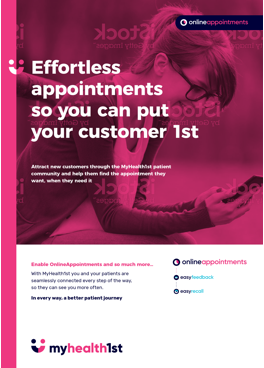
As of April 27, the ADA has lessened dental restrictions to level 2, allowing for procedures unlikely to cause aerosols and have presence of limited saliva or blood. Telehealth can be an invaluable tool for dentists to connect with and triage patients before appointments to gauge urgency of care and whether any restrictions might apply as well as for offering aftercare without the need for in-person appointments.
What Is Telehealth?
Telehealth is the practise of remotely connecting with a patient for consultation, diagnosis and treatment. In a broad sense, any appointment that doesn’t require direct physical intervention or specialist equipment can be carried out via telehealth. Some more specialist testing or monitoring can also be performed remotely if the patient has access to telehealth medical devices, such as blood pressure and glucose monitors with online functionality capable of sending results directly to a consulting physician, nurse or specialist.
There are two forms of telehealth commonly practiced: synchronous and asynchronous.
1. Synchronous telehealth refers to when you directly connect with a patient via teleconferencing, video chat or over the phone.
2. Asynchronous telehealth refers to “store and forward”, a practice by which a primary care physician can capture images or video of a patient to send to a specialist for further analysis.
As dentists you will most likely be using synchronous telehealth to connect with patients to gauge the urgency of their appointment, what kind of safety measures you may have to adopt for their procedure or whether the appointment can be deferred until restrictions are lowered.
Until recently, telehealth services in Australia have been limited to remote communities and those with mobility or accessibility issues preventing them from easily attending face-to-face appointments, but with the advent of COVID-19, strict social distancing and lockdown, telehealth services have been made available for all. In addition to offering accessibility to patients, telehealth services have a number of benefits for both practices and patients:
- Reduces or negated threat of COVID-19 infection
Offering telehealth consults reduces exposure to potential threats of infection, whether it be COVID-19, a seasonal flu, a measles outbreak or other virulent virus. Even if you mix face-to-face consults with telehealth appointments, the reduced number of in-person practice visits also limits possible vectors of infection. The MyHealth1st booking platform features optional COVID-19 pre-screening, allowing customers to further increase the safety of their practice.
- Preparation
Urgent care is always necessary but these urgent procedures can be dangerous when it comes to potential infection. Being able to connect with patients before the procedure via telehealth can enable you to prepare the practice for potential threats, including suspected COVID-19 infection or high volumes of aerosols or other infectious material.
Technological Requirements
Setting up your practice for telehealth consults may seem like a large technological hurdle, but the technology required is readily available and you will most likely have most of it on hand already. While it is possible to do some telehealth consults via Skype, Zoom, Whatsapp or other video conferencing platform, these aren’t necessarily secure, with people potentially being able to listen in to or interrupt other patient’s appointments.
No matter the platform, for video conferencing you will need a camera and either a microphone or a headset with a built in mic.
There are no specific technologies required to be eligible for MBS incentives other than the necessity that the technology or service used adheres to Australian Privacy Principles .
MyHealth1st and Telehealth
Depending on the platform you choose there may be privacy or security concerns that need to be tackled. Ideally a practice should use a secure end to end telehealth solution, such as the MyHealth1st browser-based, encrypted and fully secured solution.
Our telehealth service works with most browsers and is fully encrypted so you can conduct a consult without fear of a patient’s privileged information being released. Up to four people can be involved in a consult using the MyHealth1st telehealth service, and built in tools such as a whiteboard, file transfer and screen sharing allow you to interact with patients in a meaningful way.
If you choose to use our telehealth service, there’s no need to fill in Skype information or Zoom addresses for an appointment, or to contact patients beforehand to give them the details of how the appointment will be conducted. When a patient books an appointment, both the patient and the practitioner are sent an email with a unique link to the telehealth session. The link only goes active 10 minutes before the appointment is due to start and requires no third party programs or apps to run.
Telehealth standards and guidelines for dental practices don’t differ greatly from those for normal consults, but do have stricter guidelines for patient consent and adequate technology. When performing a telehealth consultation, a dentist must:
- Obtain the patient’s informed consent to participate in a telehealth consult and ensure patient confidentiality and privacy.
- Decide on the appropriateness of a telehealth consult or whether proper care requires a face-to-face consult.
- Make their identity known to the patient.
- Confirm the identity of the patient to the best of their ability.
- Explain to the patient the processes in the telehealth consult.
- Obtain and assess the patient’s medical history, condition and clinical signs to aid examination.
- Accept ultimate responsibility for evaluation of information, assessment and treatment.
- Keep an adequate record of the consultation.
There may be other mandated telehealth guidelines that must be followed for your modality, so check with the Australian Dental Association to keep abreast of any requirements or restrictions to which you must adhere.
To register for MyHealth1st's integrated, clinically validated telehealth solution - click here
What Kind of Services can be Offered?
For the most part, any consultation that doesn’t require direct physical proximity or intervention is possible to offer through telehealth. Determinations of appropriateness must naturally be made on a case by case basis depending on symptoms, urgency and the type of treatment desired. What kind of services varies depending on modality, but include:
- Triage: Determining the urgency of an appointment via telehealth allows you to easily defer or reschedule low urgency appointments.
- Aftercare: Telehealth is also a great tool for providing aftercare for dental surgery or orthodontics, enabling you to check on patients without having to schedule a face to face appointment..
Implementing telehealth services is a great first step, but it's vital you let your patients know that you now offer this service. Letting them know how to book a telehealth appointment is equally important.
We suggest a dding information to your website which links into your MyHealth1st bookings to streamline user flow and drive patient bookings. Updating your practice "on hold" recordings to inform patients they can now book a telehealth consultation with your practice online can also help patients discover the service.
Sending out a mass communication to your patients via email and/or sms informing them of this new service can help drive rapid adoption.
Don’t hesitate to reach out to the MyHealth1st team if you'd like any help with this.
If you have any questions about implementing a telehealth service for your practice, or are interested in utilising our extensive experience to help your practice grow and thrive in these uncertain times, the team at MyHealth1st is ready to help.
